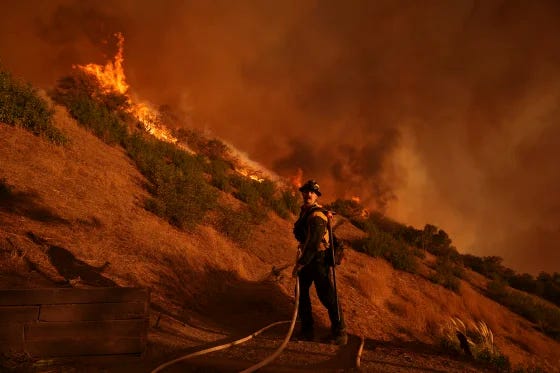Deadly Wildfires Ravage Los Angeles Area: What We Know So Far
Powerful Winds and Dry Conditions Spark Devastating Fires, Leaving Deaths and Destruction in Their Wake
LOS ANGELES — A series of catastrophic wildfires ignited in the Los Angeles area on January 7, fueled by strong winds and dry conditions. The blazes have claimed at least 27 lives, including some victims who perished while trying to protect their homes, and caused widespread destruction, leveling thousands of structures.
A Los Angeles County fire official reported numerous significant injuries linked to two of the largest fires. A city official described the night of January 7 as “one of the most devastating and terrifying” in recent memory, underscoring the gravity of the situation. Here's what we know about the ongoing crisis:
Where Are the Fires?
The Palisades Fire began the morning of January 7 in Pacific Palisades, a neighborhood located east of Malibu. Initially a brush fire, it rapidly expanded to 23,713 acres and was 70% contained by Wednesday night, according to the California Department of Forestry and Fire Protection (Cal Fire). The fire has damaged or destroyed over 7,400 structures.
Shortly after the Palisades Fire, the Eaton Fire ignited near a canyon in the national forest lands north of downtown Los Angeles. By Wednesday evening, the fire had spread across 14,021 acres and was 95% contained. More than 10,400 structures were confirmed as damaged or destroyed.
As the fire crews battled the largest blazes, additional fires broke out across Los Angeles, but firefighters managed to prevent their spread and contain the flames. By Friday night, Cal Fire reported that the Lidia, Archer, Woodley, Sunset, Kenneth, Hurst, and Auto fires were all 100% contained, collectively burning 2,399 acres.
Casualties and Injuries
As of Thursday afternoon, Los Angeles County officials confirmed that at least 27 people had lost their lives in the fires. Many of the deaths are still under investigation by the county medical examiner’s office, which has not yet been able to confirm the identities of the deceased. It could take several weeks to identify all the victims.
Of the confirmed deaths, 17 occurred in the Eaton Fire, and 10 in the Palisades Fire. Authorities have warned that the death toll could continue to rise as more bodies are recovered.
In addition to the fatalities, there have been significant injuries, with many people reportedly harmed for failing to evacuate in time, especially in the Palisades Fire.
Evacuations and Displacement
At the height of the crisis, nearly 200,000 people were under evacuation orders as emergency crews fought to control the blazes. By Tuesday morning, the number of evacuees had dropped to about 88,000, with another 84,800 still living in evacuation warning zones throughout Los Angeles County.
While some areas have begun limited repopulation, many neighborhoods have been completely destroyed, leaving an uncertain number of residents homeless.
Damage and Economic Impact
The financial toll from the fires is expected to be staggering. JPMorgan estimates that insured losses from the fires could surpass $20 billion, with total economic losses possibly reaching $50 billion. These figures would far exceed the $12.5 billion in damages caused by the 2018 Camp Fire, which previously held the record for the costliest wildfire in U.S. history.
Cause of the Fires
The exact cause of the fires remains under investigation, but experts point to the combination of severe drought conditions and strong offshore winds as the primary contributors. Southern California has received less than 10% of its average rainfall since October, creating the perfect conditions for rapid-fire spread.
The National Weather Service issued a red flag warning, indicating extreme fire danger, to 19 million people. Wind gusts of over 70 mph were recorded in several areas across the region.
Climate scientists suggest that California’s recent experience of fluctuating weather patterns—alternating between drought and heavy rainfall—has made the region more susceptible to destructive wildfires. Daniel Swain, a climate scientist, explained that this weather "whiplash" is particularly harmful, as it intensifies the fire risk in Southern California.
As the fire season continues, the Los Angeles area remains on high alert, with authorities working tirelessly to control the blazes and prevent further loss of life and property. The devastating impact of these wildfires serves as a stark reminder of the growing threat posed by climate change and its effects on wildfire risk.


